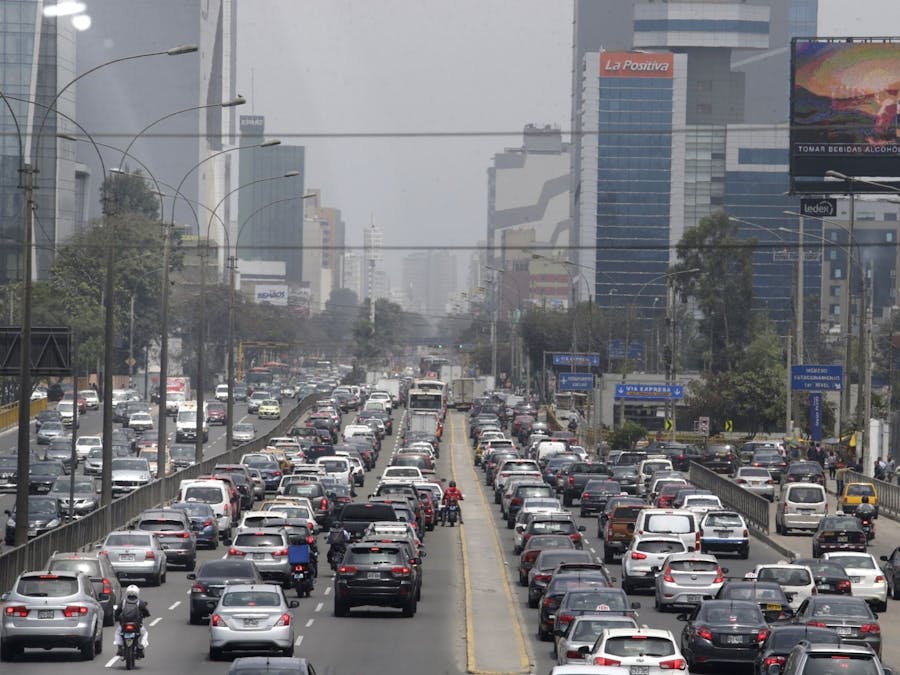Lima, the capital city of Perú, has one of the worst traffic in the world according to the TomTom Traffic Index, ranked third in 2018 and seventh in 2019 (https://www.tomtom.com/en_gb/traffic-index/lima-traffic). Because of that, Peru’s government has taken some actions to control and reduce traffic congestion, one of them is called “Pico y Placa”, which is a driving restriction policy. The scheme of “Pico y Placa” restricts vehicles based on the last digit of the license plate numbers (even and odd). Cars with odd license plate last digit can road only Monday and Wednesday and cars with even license plate last digit can road only Tuesday and Thursday. There is no restriction from Friday to Sunday.
After some months of this new road restriction, there is some good results with fewer trip times for the public bus transportation system (http://www.protransporte.gob.pe/con-hora-pico-y-placa-se-redujo-tiempo-de-viaje-en-tres-corredores-viales). However, the benefit could be even greater, but many drivers are breaking the law by driving their cars the days when it is not allowed (https://diariocorreo.pe/edicion/lima/muchos-conductores-no-respetan-restriccion-edil-de-pico-y-placa-900151/). Right now, there is some level of monitoring done by police officers, but this is manual: a police officer with a camera record a video and then this video is reviewed by other agents to detect an offense (see Figure 1). Because of this, the monitoring is only done in a few corners and of course, bad drivers take advantage of this. Also, drivers inform others about the position of the police officers with the cameras using the chat feature of Waze, making law enforcement very difficult and expensive.
Figure 1. Police Officer monitoring road restriction using a simple video camera
The Solution: Real time Road Space Rationing control using Jetson NanoBased on this scenario, we believe that this “Pico y placa“ monitoring in Perú (and also in other countries with similar restrictions like Colombia or Mexico) could be done automatically, in real-time and using cheap hardware and software. That’s why we made a portable solution that could be installed in the streets to take a video of the cars using a standard webcam and detecting the cars inside the video using a Mobilenet SSD model optimized for TensorRt. Then we take the picture of the detected car and identify its license plater by sending it to the OpenALPR module in order to check if it is compliant with the law. Also, we are using DeepSort tracking model to avoid calling the OpenALPR module in each video frame, but only the first frame where the car is detected. We have also implemented a buzzer to make a sound when an offender car is detected by the system. This would allow a police officer to stop this offender at that moment. Also, this system could be replaced by other types of integrations in the future like issuing traffic tickets automatically or showing the offender’s license plate on a big screen.
This approach of executing all the video analytics at the Edge using cheap components would allow installing the control devices in many streets without worrying for expensive internet connection and bandwidth.
Here there is the detail of how we made it:
1. INSTALLATION OF ENVIRONMENT1.1. Requirements- Jetson Nano Developed Kit
- SD CARD 64 GB class 10
- Good internet connection
- Monitor
- Keyboard
- Mouse
- USB webcam
It is necessary to use all the memory of the jetson nano, for this there are 2 alternatives to flash the operating system:
SDKMANAGERProblem with SDKMANAGER:
According to the Tegra Linux Driver documentation in the 2.0 Known Issues part: https://docs.nvidia.com/jetson/archives/l4t-archived/l4t-321/pdf/Tegra_Linux_Driver_Package_Release_Notes_R32.1.pdf
You can only burn an sd card with the size of 14 GB:
That is why I have seen fit to use option 2.
Download image and flash with BalenaEtcher
The available image https://developer.nvidia.com/embedded/downloads is used:
Be sure to use the one that comes with Opencv 3.*, because the plate recognition algorithm works with it.
username : dlinano
password : dlinano
By default, it consumes an average of 14 GB when it bounces the first time.
1.3. Preparing the systemDownload the repository:
https://github.com/CristianLazoQuispe/Pico_y_placa.git
Save it in the documents folder
1.3.1. Test the image before you startIt is important to make sure that the image is working properly, to do this we must run the code read_camera_web.py:
Open terminal
Execute: https://github.com/CristianLazoQuispe/Pico_y_placa
python3 read_camera_web.py
If everything is correct you should see the camera reading in grayscale.
Installing the libraries is a very tedious job because of compatibility issues and installation time.
$ sudo apt-get update
$ sudo apt-get install -y python3-dev python3-numpy python3-py python3-pytest
$ sudo apt-get install git cmake
$ sudo apt-get install libatlas-base-dev gfortran
$ sudo apt-get install libhdf5-serial-dev hdf5-tools libhdf5-dev zlib1g-dev zip libjpeg8-dev$ sudo python3 -m pip uninstall pip setuptools wheel
$ sudo apt-get --reinstall install python3-setuptools python3-wheel python3-pip$ sudo pip3 install -U pip testresources setuptools
$ sudo pip3 install -U numpy==1.16.4 future==0.17.1 mock==3.0.5 h5py==2.9.0 keras_preprocessing==1.0.5 keras_applications==1.0.8 gast==0.2.2 enum34 futures protobuf
$ sudo pip3 install --extra-index-url https://developer.download.nvidia.com/compute/redist/jp/v42 tensorflow-gpu==1.13.1+nv19.3First it is necessary to find the address of cuda in the system, you can find the path using the command:
$ find / -type d -name cuda 2>/dev/nullIn my case:
/usr/local/cuda-10.0
Execute this commands:
$ export PATH=$PATH:/usr/local/cuda-10.0/bin
$ export CPATH=$CPATH:/usr/local/cuda-10.0/targets/aarch64-linux/include
$ export LIBRARY_PATH=$LIBRARY_PATH:/usr/local/cuda-10.0/targets/aarch64-linux/lib
$ source ~/.bashrc
$ nvcc --versionIn my case:
Download the version of pycuda pycuda 2019.1.2 using the link below
https://pypi.org/project/pycuda/#files
Execute the following commands for the pycuda installation
$ cd pycuda-VERSION
$ python3 configure.py --cuda-root=/usr/local/cuda-10.0
$ sudo make install$ sudo apt-get install python3-scipy
$ sudo pip3 install imutils
$ sudo pip3 install keras
$ sudo apt-get install python3-matplotlib
$ sudo apt-get install libpcap-dev libpq-dev
$ sudo pip3 install cython$ wget http://releases.llvm.org/7.0.1/llvm-7.0.1.src.tar.xz
$ tar -xvf llvm-7.0.1.src.tar.xz
$ cd llvm-7.0.1.src
$ mkdir llvm_build_dir
$ cd llvm_build_dir/
$ cmake ../ -DCMAKE_BUILD_TYPE=Release -DLLVM_TARGETS_TO_BUILD="ARM;X86;AArch64"
$ make -j4
$ sudo make install
$ cd bin/
$ echo "export LLVM_CONFIG=\""`pwd`"/llvm-config\"" >> ~/.bashrc
$ echo "alias llvm='"`pwd`"/llvm-lit'" >> ~/.bashrc
$ source ~/.bashrc
$ sudo pip3 install llvmlite==0.30.0Before proceeding to the Numba installation, you need to perform the LLVM installation above first since Numba is heavily rely on LLVM installation.
$ sudo pip3 install numba==0.34.0$ sudo apt-get install gfortran
$ sudo pip3 install https://github.com/scikit-learn/scikit-learn/archive/0.20.1.tar.gz$ sudo apt-get install python3-skimage
$ sudo pip3 install -U scikit-image$ sudo apt remove python3-scipy
$ sudo apt install --reinstall python\*-decorator
$ sudo apt install -f
$ sudo apt install python3-scipy
$ sudo apt-get updateFirst you need to download this repository:
https://github.com/NVIDIA/jetson-gpio
$ sudo python3 setup.py install
$ sudo groupadd -f -r gpio
$ sudo usermod -a -G gpio dlinano
$ sudo cp /opt/nvidia/jetson-gpio/etc/99-gpio.rules /etc/udev/rules.d/
$ sudo udevadm control --reload-rules && sudo udevadm trigger$ sudo pip3 install RPLCD==1.2.2
$ sudo pip3 install filterpy$ sudo add-apt-repository ppa:alex-p/tesseract-ocr
$ sudo apt-get update
$ wget http://www.leptonica.org/source/leptonica-1.78.0.tar.gz
$ tar xvf leptonica-1.78.0.tar.gz leptonica-1.78.0
$ cd leptonica-1.78.0
$ ./configure
$ make -j $(($(nproc)-1))
$ sudo make install
$ cd ~
$ git clone https://github.com/tesseract-ocr/tesseract.git
$ cd tesseract
$ ./autogen.sh
$ ./configure
$ make -j $(($(nproc)-1))
$ sudo make install
$ sudo ldconfig
$ cd ~Materials:
- Medium-density fibreboard (MDF) 3 mm A3 sheet
- Screws m3 x 8 mm (to fix the support plate to the box)
- Screws m3 x 20 mm (for fixing the fan)
- 5V fan
A proprietary design is used for the nano jetson case consisting of 6 pieces that are assembled to form the complete structure.
2.1. Main base:- 2 Resistor 330 ohms
- 1 Resistor 10k ohms
- 1 Resistor 1k ohms
- 1 Buzzer
This circuit was inspired by this repository:
https://www.jetsonhacks.com/2019/06/07/jetson-nano-gpio/
Custom design on Proteus:
PCB design:
Real Time Road Space Rationing control using Jetson Nano
5.1. GETTING STARTED5.1.1. Using ISO- Download the image of jetson nano with all libraries and code implemented :
https://drive.google.com/drive/folders/1_XjzvR0key_jjU8aexq3Zpe6h2fgbZnz?usp=sharing
- Open folder Pico_placa_SSD :
cd home/dlinano/Documents/Pico_placa_SSD- Run code pico_placa.py
python3 pico_placa.py- If you want to use special hardware of image capture:
- webcam :
self.video = cv2.VideoCapture(0)
- video :
self.video = cv2.VideoCapture('PATH_OF_VIDEO')
- picam :
self.video = cv2.VideoCapture(gstreamer_pipeline(flip_method=0), cv2.CAP_GSTREAMER)
5.1.2. Step by stepDownload the repository:
https://github.com/CristianLazoQuispe/Pico_y_placa.git
Save it in the documents folder
- Follow the instructions of installation on pdf:
Pico_y_placa.pdf
5.1.2.1. SSD MobileNetThis project use the model od SSD MobileNet on TensorRT
We use the model of the repository tensorrt_demos:
git clone https://github.com/jkjung-avt/tensorrt_demos.gitDownload and implement the TensorRT model from SSD Mobilenet and copy it to the ssd folder
5.1.2.2. OpenALPRDownload the repository and copy the runtime_data folder to Pico_y_placa:
git clone https://github.com/openalpr/openalpr.git

















Comments
Please log in or sign up to comment.